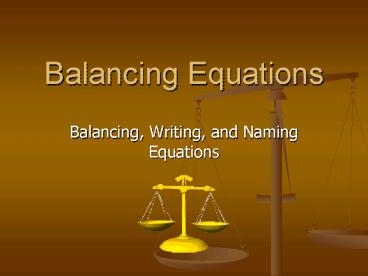Balancing Equations
1 / 26
Title: Balancing Equations
1
Balancing Equations
- Balancing, Writing, and Naming Equations
2
Balancing Equations
3
Balancing Equations
- Law of Conservation of Matter
- In a chemical reaction, matter can be neither
created nor destroyed. - In a chemical reaction, the amount of reactants
equal the amount of products. - So, the mass of the reactants and products should
equal each other if this law is followed.
4
Balancing Equations
- Paraphrase
- Law of Conservation of Atoms
- The number of atoms of each type of element must
be the same on each side of the equation.
5
Balancing Equations
- Balancing hints
- Balance the metals first.
- Balance the ion groups next.
- Balance the other atoms.
- Save the non ion group oxygen and hydrogen until
the end.
6
Balancing Equations
- Hydrogen oxygen water
- H2 O2 H2O
- Hydrogen and oxygen are diatomic elements.
- Their subscripts cannot be changed.
- The subscripts on water cannot be changed.
7
Balancing Equation
- H2 O2 H2O
- Count the atoms on each side.
- Reactant side 2 atoms H and 2 atoms O
- Product side 2 atoms H and 1 atom O
8
Balancing Equations
- H2 O2 H2O
- If the subscripts cannot be altered, how can the
atoms be made equal? - Adjust the number of molecules by changing the
coefficients.
9
Balancing Equations
- H2 O2 2H2O
- Balance one atom at a time Lets start with
balancing oxygen! - Use the distribution rule from math class to
balance equations! - Ex. 3 (x 2) 3x 6
- Reactants 2 atoms of H and 2 atoms of O
- Products 4 atoms of H and 2 atoms of O
- H is no longer balanced!
10
Balancing Equations
- 2H2 O2 2H2O
- Now try to balance the hydrogens by placing a 2
in front of the reactant H2 - Reactant side 4 atoms of H and 2 atoms of O
- Product side 4 atoms of H and 2 atoms of O
- Its Balanced!
11
Balancing Equations
- N2 H2 NH3
- Nitrogen hydrogen ammonia
- Count atoms.
- Reactants 2 atoms N and 2 atoms H
- Products 1 atom N and 3 atoms of NH3
12
Balancing Equations
- Nothing is balanced.
- Balance the nitrogen first by placing a
coefficient of 2 in front of the NH3.
- N2 H2 2NH3
13
Balancing Equations
- Hydrogen is not balanced.
- Place a 3 in front of H2.
- Reactant side 2 atoms N, 6 atoms H
- Product side 2 atoms N, 6 atoms H
- Its balanced!
- N2 3H2 2NH3
14
Balancing Equations
- Cu H2SO4
- CuSO4 H2O SO2
- Count Atoms
- Reactants Cu 1, H 2, S 1, O 4
- Products Cu 1, H 2, S - 2, O - 7
15
Balancing Equations
- Sulfur is not balanced.
- Place a two in front of sulfuric acid.
- Count atoms 2 H2SO4 H 4, S 2, O - 8
- Cu 2H2SO4
- CuSO4 H2O SO2
16
Balancing Equations
- Hydrogen needs to be balanced so place a 2 in
front of the H2O. - Count the number of atoms.
- Cu 2H2SO4
- CuSO4 2H2O SO2
17
Balancing Equations
- Reactants Cu 1, H 4, S 2, O 8
- Products Cu 1, H 4, S 2, O 8
- Its balanced!
- Cu 2H2SO4
- CuSO4 2H2O SO2
18
Balancing Equations
- Ca3(PO4)2 H2SO4 CaSO4 H3PO4
- Count atoms.
- Reactants Ca 3 atoms, P 2 atoms, O 8
atoms H atoms, S 1 atom, O 4 atoms
19
Balancing Equations
- Side note on Ca3(PO4)2
- The subscript after the phosphate indicates two
phosphate groups. - This means two PO43- groups with two P and eight
O atoms.
20
Balancing Equations
- Ca3(PO4)2 H2SO4 CaSO4 H3PO4
- Count atoms in the product.
- Ca atoms 1, S atom 1, O atoms 4 H atoms
3, P atom 1, O atoms - 4
21
Balancing Equations
- In this equation, the ion groups do not break up.
- Instead of counting individual atoms, ion groups
may be counted.
- Ca3(PO4)2 H2SO4 CaSO4 H3PO4
22
Balancing Equations
- Ca3(PO4)2 H2SO4 CaSO4 H3PO4
- Reactants Ca2 3, PO43- - 2, H 2, SO42 -
1 - Products Ca2 - 1, SO42- - 1, H - 3, PO43- - 1
23
Balancing Equations
- Balance the metal first by placing a coefficient
of 3 in front of CaSO4. - Products Ca 3 atoms, SO42- - 3 groups
- Ca3(PO4)2 H2SO4 3CaSO4 H3PO4
24
Balancing Equations
- Three sulfate groups are needed on the reactant
side so place a coefficient of 3 in front of
H2SO4. - 3H2SO4 gives 6 H and 3 SO42-.
- Neither phosphate nor calcium is balanced.
- Ca3(PO4)2 3H2SO4 3CaSO4 H3PO4
25
Balancing Equations
- A coefficient of 2 placed in front of H3PO4 which
balances both hydrogen and phosphate.
- Ca3(PO4)2 3H2SO4 3CaSO4 2H3PO4
26
Balancing Equations
- This method of balancing equations is trial and
error. - Practice.































